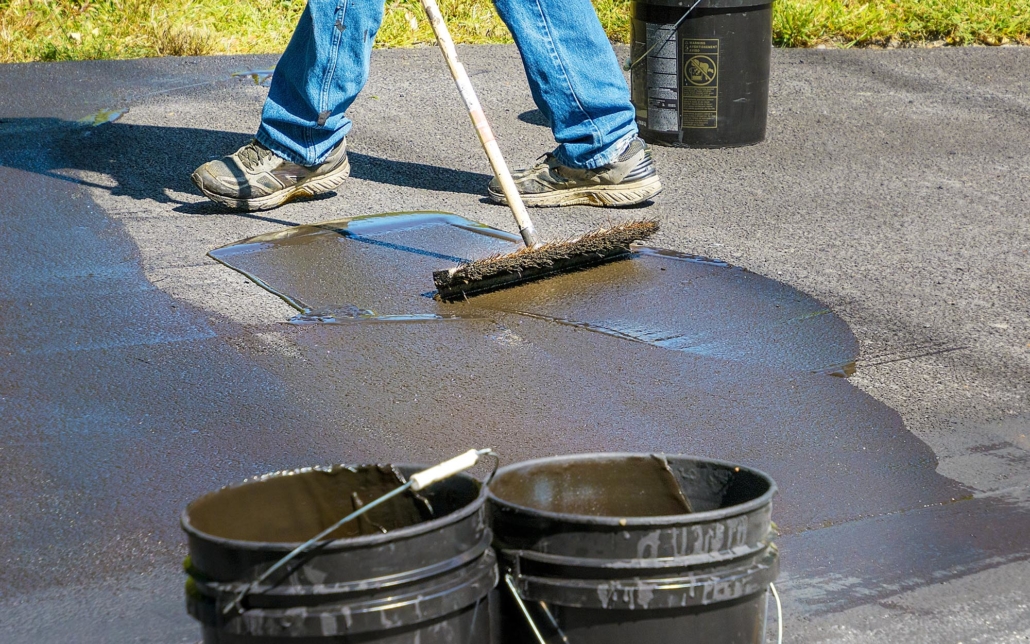Renew Angle Parking Lots: Asphalt Sealing Techniques Exposed
Renew Angle Parking Lots: Asphalt Sealing Techniques Exposed
Blog Article
Cold Mix Asphalt Vs. Hot Mix Asphalt: Which Is Right for You?

Structure Differences
Cold mix and hot mix asphalts vary considerably in their structure, with unique qualities that influence their performance and applications. Cold mix asphalt is generated by emulsifying the asphalt binder with water and an emulsifying agent prior to blending it with accumulation. This technique permits the asphalt to be workable at reduced temperatures, making it ideal for temporary repair work and for use in chillier climate conditions. Warm mix asphalt, on the other hand, is manufactured at high temperature levels, normally in between 300-350 ° F, which assists to achieve far better compaction and a more long lasting end product. The warm mix asphalt production process involves warming the aggregate and asphalt binder separately before incorporating them at the asphalt plant.
Moreover, chilly mix asphalt tends to be less thick and much more adaptable than warm mix asphalt. This versatility makes it better fit for locations with higher levels of movement, such as driveways or roadways with rush hour. On the other hand, warm mix asphalt is understood for its high toughness and resistance to rutting and cracking, making it a favored choice for highways and high-traffic roads where longevity is important.
Installment Process Variances
The procedure of installing cool mix and warm mix asphalt exhibits remarkable variances in their procedures and demands. Cold mix asphalt, being a more flexible material, can be used directly from the bag or container onto the crater or harmed area. It calls for minimal preparation job, such as cleaning the location and condensing the cool blend with hand tools. This makes it a convenient alternative for short-term and quick fixes. In comparison, warm mix asphalt requires an extra fancy installation procedure. It involves warming the blend to heats before laying it down on an effectively ready base. The prep work consists of compacting the base, using a tack layer, and utilizing heavy equipment like pavers and compactors for a smooth and durable coating. Due to the heating demands, hot mix asphalt setups are usually lugged out by specialists with customized equipment, ensuring a more structurally sound and irreversible outcome.
Sturdiness and Long Life Aspects
When taking into consideration asphalt alternatives, longevity and long life are critical elements to review for lasting sidewalk efficiency. Hot mix asphalt (HMA) is known for its phenomenal sturdiness and long life.
In regards to durability, HMA generally Click Here exceeds CMA as a result of its remarkable toughness and resistance homes. HMA sidewalks have a longer life span, calling for much less frequent fixings and upkeep, which can translate to cost financial savings in the long run. Furthermore, HMA sidewalks are a lot more easily customizable to fulfill certain task demands, additionally improving their sturdiness.
Price Factors To Consider
Considering the financial implications is an essential facet when reviewing the selection between warm mix asphalt (HMA) and chilly mix asphalt (CMA) for pavement projects. While the initial cost of hot mix asphalt is generally greater than that of chilly mix asphalt, HMA usually gives a more cost-efficient service in the long run due to its exceptional durability and long life.
In enhancement to material prices, it's essential to consider the expenditures connected with installation and maintenance when comparing HMA and CMA. Inevitably, the choice between HMA and CMA must take into account not simply the first expense yet additionally the lasting economic implications to establish the most economical option for the details pavement job.
Environmental Impact Comparison
Contrast of the environmental effects in between hot mix asphalt (HMA) and chilly mix asphalt (CMA) exposes distinct differences in sustainability techniques. HMA manufacturing needs high temperatures, leading to increased power consumption and greenhouse gas exhausts. The process also releases volatile natural substances (VOCs) and harmful air pollutants (HAPs) right into the atmosphere. On the other hand, CMA is generated and applied at lower temperature levels, reducing energy use and exhausts dramatically. The reduced production temperatures of CMA lead to reduced fuel usage and reduced levels of CO2 discharges, making it an click to find out more extra ecologically pleasant choice.
Additionally, the use of CMA usually involves recycling existing asphalt sidewalk, advertising source conservation and decreasing the quantity of waste sent out to landfills. This recycling element even more boosts the sustainability of CMA contrasted to HMA. In general, when taking into consideration the ecological impact, CMA becomes a much more environmentally lasting selection because of its reduced power needs, reduced emissions, and the possibility useful source for recycling existing materials. By deciding for CMA over HMA, road building tasks can add favorably to environmental conservation initiatives.
Final Thought
To conclude, the option in between cool mix asphalt (CMA) and hot mix asphalt (HMA) relies on different variables such as composition, setup procedure, toughness, long life, cost, and ecological effect. asphalt repair. While CMA offers a quick and cost-efficient remedy for minor fixings, HMA ensures exceptional toughness and long life for rush hour locations. Take into consideration these aspects meticulously to identify which sort of asphalt is the best choice for your paving needs

Taking into consideration the monetary implications is an essential aspect when reviewing the option in between hot mix asphalt (HMA) and cold mix asphalt (CMA) for pavement jobs. While the initial price of hot mix asphalt is normally higher than that of chilly mix asphalt, HMA often provides a more economical solution in the long run due to its premium durability and longevity. asphalt repair.Comparison of the environmental influences between hot mix asphalt (HMA) and cool mix asphalt (CMA) discloses distinctive differences in sustainability methods.In conclusion, the option between cold mix asphalt (CMA) and warm mix asphalt (HMA) depends on various aspects such as composition, installment process, resilience, durability, cost, and ecological influence
Report this page